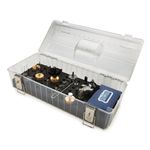Tool Storage: Are you in or out?
Vic Tesolin likes to have his tools out in the open where he can see them, and more importantly use them.
After recently moving into and setting up a new shop, tool storage is on my mind. There are more ways to store hand tools than there are woodworkers, and they generally fall into two camps—in or out. Some woodworkers like to store their tools “in” something. That could be anything from a cardboard box to a tool chest on the floor. Tool cabinets are another “in” solution, whether they are pre-fab melamine or painstakingly crafted cabinets. One of the most famous of these is the Studley tool chest, which has garnered plenty of interest and has inspired many woodworkers to riff off of the design.
The reasons for storing tools in something are many, but some of the common ones make the most sense to me. Storing them this way keeps them free (relatively) from dust. There is moisture in dust and that can lead to rust. Dust rust is not the only type of rust, though. For those who don’t work in a climate-controlled shop, the unchecked humidity can wreak havoc on metal tools. I’ve never lived on either coast but I understand that areas close to salt water can be brutal on tools. If the tools are stored inside something, presumably you can mount some sort of dehumidifying product in the chest to help control the rust.

Another reason to store tools in something is to keep things organized. We’ve all seen tool cabinets that have a spot reserved for every tool. A spot for everything and everything in its spot is a beautiful thing. Again, the Studley chest is a fine example of how far one could go with this idea. Don’t get me wrong, I love the Studley chest, but I’m not going to be building one for myself anytime soon. Floor tool chests work for me and don’t seem as fussy about what goes where. In mine, I have a measuring till, chisel till, etc., but I don’t have a slot for every tool.
Here is what I’ve learned after 20 years of storing tools. I like to have my tools out in the open where I can see them. From a shop design perspective, I like they way all the tools look. It’s easy and functional decor. From a creativity perspective, I like seeing the tools and being inspired by them or remembering the story behind them. From a functional work perspective, I like being able to look up, spot the dividers I want, reach for them, and put them to use. I tried working out of an English-style floor chest for a couple of years and I didn’t enjoy it. That being said, I still have that chest that I inherited (it was made in the early 1800s) and I put tools that I don’t use often in there. Things like my bench chisels, measuring and marking tools, and saws all live out in the open.
I guess I’m in both camps as I speculate a lot of you are too. I’m not so worried about rust in my shop because I’m fastidious about cleaning and I oil down my often-used tools at the end of every project. Any tools that I use less often have a bit more oil on them to get them through the longer spells of not being handled. In the end, store your tools however works for you, enjoy woodworking, and don’t worry too much about the rest.
So how do you store your hand tools? Are they in, out, or a bit of both?
Check out this tour of Vic’s new shop he streamed recently:
 |
|
 |
|
 |
Fine Woodworking Recommended Products

WoodRiver Router Bit Storage Case

Starrett 4" Double Square

Stanley Powerlock 16-ft. tape measure























Comments
I’m in both camps.
At the beginning of a project every tool is carefully stored in a specific spot in a cabinet or drawer.
By the end of a project every tool I own is scattered out in the open around the garage.
But seriously, I prefer a cabinet. I built Mike Pekovich’s tool cabinet from the magazine and aside from being a blast to build, it swallows up tools like a black hole. Very efficient storage.
I like to look at Studley’s chest, the craftsmanship is unreal, but it honestly looks like it would be a pain the neck to work out of. So many layers of tools tucked behind other tools.
I started out with the old peg board. When I started buying better quality tools and having a lot of plastic containers for various brands of power tools, I started on the French cleat system as a temporary system as I was re organising my shop and in between projects. I soon discovered that my good tools were starting to rust up (I live on the coast and my shed is an old barn with heaps of dust and draft, so I have been building cabinets in between projects. I use the cabinet building to practice a new technique ie dovetails, new finishes etc. To stop or slow down the rust problem, I throw in the gel packets to absorb any moisture and apply a coating of rejuvenate onto the metal.
I also like having my go to hand tools hanging visibly on the wall in reaching distance from my workbench. Below that, I have a standard off-the-rack variety rolling tool box with trays and drawers for all the other hand tools I have to reach for often, but don't necessarily want to look at all the time - i.e. wrenches, pliers, screw drivers etc. After dreaming up all sorts of options for the wall storage, I settled on bits of scrap wood made into long L-brackets screwed into the wall with different size holes drilled in them. I also made angled kerf cuts in those same L brackets to hold my Japanese saws. I would like to have some angled spots for my hand planes, but for now shallow flat shelving is working for those, with the planes stored on their sides. Also I've had no problem with either nails or screws or little bits of wood just screwed to the wall to hang things like spoke shaves and draw knives. The result is something that can best described as 'eclectic yet functional' which I'd say describes me and my work pretty accurately as well!
Early on, about 30 years ago, I built a wall hanging tool cabinet with some tools easily accessible and some in drawers. But I have slowly migrated to having my tools out and within easy reach. I recently built a mini bench top bench and decided to include a holder for my most frequently used tool, the chisel. It's been a very positive addition to my work flow and work environment.
Many thanks for your effort, Vic! Your blog post is quite informative for those looking forward to storing hand tools.
Log in or create an account to post a comment.
Sign up Log in